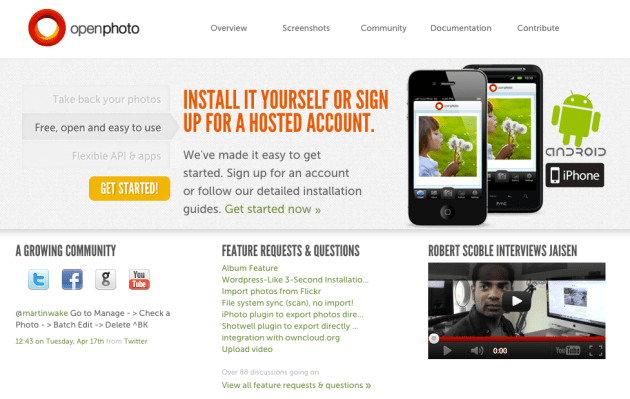If you’ve ever scoffed at Flickr, felt that photo sharing and storage websites hold your photos hostage, or associated photos on the Web with platform lock-in, then you’ve already started to get a sense of why Jaisen Mathai left Yahoo last year to build OpenPhoto. Appalled by having to watch Yahoo let an awesome startup/service like Flickr go to seed, (“I was extremely frustrated by the lack of product vision,” Mathai said at the time), he took to Kickstarter and raised the $25K he needed to get it off the ground.
That was July of last year. Since then, Mathai joined WebFWD, Mozilla’s Open Innovation program, which gives select entrepreneurs 1:1 mentorship, access to the Mozilla global network, infrastructure support, etc. Today, OpenPhoto has a new, redesigned website, a brand, spanking new iPhone app, and Mathai has recruited an all-star team of designers and engineers, ex-Yahoo, ex-Apple, current Twilio and Mozilla engineers, a principal designer of OStatus protocol, and the organizer of the Scale Linux conference, to name a few, who are all donating their time to the project.
Again, as you might have guessed, the biggest value proposition for OpenPhoto, and something Mathai has become obsessed with, is that it is meant to be immune to a website, service or application dying, paradigm shifts and changings of the guard. The founder believes OpenPhoto is the only photo service where users have more control and access to their photos than the service itself, which means that everything is done on the user’s terms — and that right there is OpenPhoto’s main differentiator from the scores of other photosharing tools out there.
This means that, in terms of how the service works, users get to select where they’d like to store their photos, whether that be on Dropbox, a personal Amazon S3 bucket, or on a hard drive. Users then have the option to let OpenPhoto scour all of your photos — those already uploaded to Flickr, Picasa, or Facebook. OpenPhoto stores them all in a central spot, which is always backed up and available on your laptop or on your phone.
 As to the service’s new iPhone app, the same features apply. Connect OpenPhoto to your Dropbox account, upload photos from your camera roll or take a photo, view, organize and share from the app, post on social networks, crop, add filters, etc. But the biggest part, with the most potential implication is that it’s all completely open sourced on Github.
As to the service’s new iPhone app, the same features apply. Connect OpenPhoto to your Dropbox account, upload photos from your camera roll or take a photo, view, organize and share from the app, post on social networks, crop, add filters, etc. But the biggest part, with the most potential implication is that it’s all completely open sourced on Github.
Mathai says that he hopes that designing OpenPhoto to be open source at its core helps bring longevity, as the history of photo sites is full of those falling out of style, shutting down, or drastic changes in focus. This leaves users in the difficult spot of having to retrieve content or deciding if they like the new service. Being open source, Mathai says, the community keeps the designers honest, and makes users a big part of how the service/UI/UX evolve, even if this means forking off in a new direction, which, when coupled with how the photos themselves are stored, means users can easily switch to a different variant or use both simultaneously.
In terms of storage, Mathai says that this is something that the team is trying to “abstract away” as much as possible, focusing more on Dropbox early on, since that’s what makes sense for most consumers. But the service may eventually begin to remove the “select your service” option and assume smart defaults that work for most users, as long as it doesn’t sacrifice one of the top priorities: Portability.
Of course, as many are well-familiar, Dropbox isn’t optimized for sharing or managing photos. And, looking at the startup’s roadmap, its not likely that they will be making a lot of improvements there, as it really lies outside their core competency — storage and syncing at scale. OpenPhoto wants to make it easy to organize and share your Dropbox photos, adding value by way of an awesome set of UIs that lie on top of Dropbox. Check out the photo below for an example.
As to monetization? When I asked Mathai if this were a project developed purely in the name of democratization and open source — mission-driven rather than financially driven, the founder gave a great response: “It’s about the mission but without money it’s moot and will become just another open source project that a bunch of nerds use.” The team plans to build a business model that is, as they say, similar to what Automattic does with WordPress. The hope is that eventually there will be an ecosystem of designers and engineers making money from OpenPhoto.
Next, we raised the question of Instagram’s $1 billion sale to Facebook, to which Mathai said he thought social (and, really, Facebook and Instagram) represented the only innovation in the photo space over the last five years, making photo sharing natural, effortless, and fun. However, on the flip side, photo management has (at least relatively) been ignored: “I think we’re actually worse off today than we were 30 years ago, in terms of managing and preserving our photos,” Mathai says.
Mathai thinks, and I tend to agree, that personal clouds will eventually win out, but this is a paradigm shift, and most companies and developers don’t think in terms of how and where that data is stored. Companies have a lot to lose by allowing users to take their content elsewhere, but it will happen, and those who stand in the way, leave a trail of unhappy ex-users as they go.
So, beyond being able to install OpenPhoto yourself, or sign up for a hosted account, the platform offers developers a set of APIs which they can use to make cool apps for the platform, and help steer it forward.
 While the startup’s iPhone app is live, the team is still working out the kinks, and wants to get the app to a point where it really sings before it focuses full-time on releasing its Android version. But Mathai said he hopes to launch on Android within the next two months, with the help of his mobile lead, Patrick Santana, who joined OpenPhoto full-time at the beginning of this year.
While the startup’s iPhone app is live, the team is still working out the kinks, and wants to get the app to a point where it really sings before it focuses full-time on releasing its Android version. But Mathai said he hopes to launch on Android within the next two months, with the help of his mobile lead, Patrick Santana, who joined OpenPhoto full-time at the beginning of this year.
All in all, OpenPhoto has come a long way since Mathai posted his project on Kickstarter last summer, and it’s been fun to watch its evolution. There’s still a long way to go, but in the wake of Instagram’s acquisition, a lot of people are looking around for the right photo sharing, photo management solution, and considering OpenPhoto gives you more control and more options than any of its kind, it stands to gain. The technology is there, and it’s improving, though it will be essential for OpenPhoto to balance its geek cred with killer consumer application. It’s definitely on the way.
And, hey, Instagram and OpenPhoto are both powered by Ubuntu, but OpenPhoto lets you manage photos with much more control, and make your Dropbox photos look sexy. And what’s better than that?
You can check out OpenPhoto on Github here, and tinker away. Or you can check out openphoto.me for the hosted version, the iPhone app here, and the project here.
Let us know what you think.

